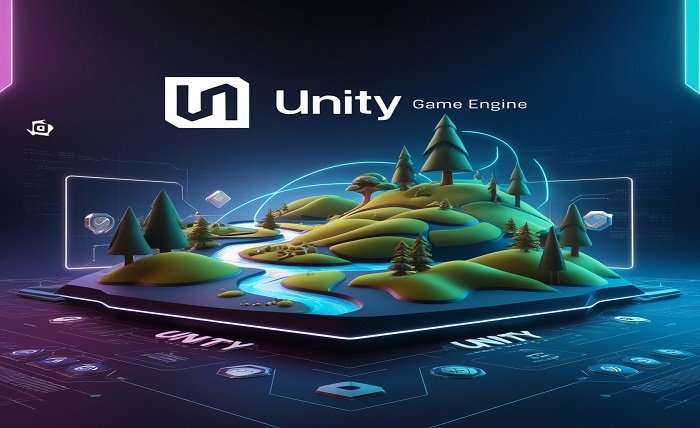Over the past few decades, there has been a huge evolution in game production, with different game engines making it easier than ever for developers to build interactive experiences and immersive environments. Unity is one of the most well-known and unity game engine on the market right now. Independent developers, studios, and even big businesses use this strong platform to realize their game concepts. In addition to its intuitive user interface, Unity is renowned for its scalability, versatility, and a wealth of tools and resources that enable developers worldwide.
What is Unity Game Engine?
Unity Technologies created the cross-platform unity game engine, which is used to create interactive simulations and 2D and 3D video games. Developers may create games for a variety of platforms, such as PCs, consoles, mobile devices, and virtual reality (VR) systems, thanks to Unity’s extensive toolkit. On a single platform, it encompasses everything from networking, audio management, physics simulations, graphics rendering, and game logic.
History of Unity Game Engine
When Unity released Unity3D in 2007, it made a significant advancement by enabling developers to produce top-notch 3D games with comparatively modest technical overhead. With the addition of features like cross-platform compatibility, an asset store, and enhanced graphics capabilities, Unity kept developing over time. With a vibrant development and user community, Unity is currently one of the most popular unity game engine worldwide.
Essential Elements of Unity
Because of its many capabilities, unity game engine is a popular option for both novice and experienced developers. Among its most noteworthy attributes are:
Support for Multiple Platforms
Developers may distribute their games across a variety of devices thanks to Unity’s broad platform compatibility. Unity can assist you in creating games that run smoothly on a variety of platforms, including PC, macOS, iOS, Android, PlayStation, Xbox, Nintendo Switch, and virtual reality.
The Visual Editor
Managing and designing game worlds is made simple by Unity’s straightforward and user-friendly Visual Editor. Without writing any code, developers may position items in the 3D world, change the lighting and texturing, drag and drop assets, and define gameplay components.
Create 2D and 3D games with Unity
unity game engine offers robust tools for both 2D and 3D game development. While Unity’s 3D features provide sophisticated rendering capabilities, such as support for physics, lighting, and intricate animations, the 2D features are made to make working with sprite-based graphics, tilemaps, and 2D physics simple.
Development of 2D Games
You can easily create puzzle games, platformers, side-scrolling games, and other 2D game genres with Unity’s 2D features. Creating captivating 2D experiences is made easy by features like Sprite Atlas, Cinemachine for 2D cameras, and Tilemaps.
Development of 3D Games
With features like NavMesh for AI pathfinding, ProBuilder for level building, and a vast library of built-in shaders for realistic graphics, Unity is a great tool for 3D game development. In addition to supporting high-fidelity rendering for AAA-caliber unity game engine, Unity can scale down to produce portable 3D experiences.
Asset Store for Unity
One of the main features that sets the engine apart and contributes to its popularity is the Unity Asset Store. A huge range of assets, such as 3D models, textures, sound files, animation packs, and whole game templates, are available in this internet marketplace. Instead of creating everything from scratch, developers can save time and effort by using the Asset Store to buy or download free assets to use in their unity game engine.
The Cross-Platform Features of Unity
unity game engine cross-platform capabilities are among its most potent features. With Unity, developers can create a game only once and have it run on several platforms with little further effort. For developers that wish to target a wide audience across several devices, this is very advantageous.
Games for Mobile
Because it can optimize games for both the iOS and Android platforms, Unity is a popular choice for mobile game production. Unity is perfect for creating mobile unity game engine because of features like touch controls, performance optimization, and automated scaling.
Games for Consoles
With the help of Unity’s console deployment tools, creators can produce top-notch games for the Xbox, PlayStation, and Nintendo Switch. Because of its adaptability and scalability, the engine can manage various platforms’ demands without sacrificing performance.
The Physics Engine in Unity
Both 2D and 3D interactions can be realistically simulated using unity game engine. NVIDIA’s PhysX engine, which supports sophisticated features like cloth simulation, particle effects, rigid body dynamics, and more, is integrated into Unity for 3D games. Unity provides a specialized 2D physics engine for 2D games that enables precise friction, gravity, and collision detection.
Conclusion
With a wealth of features for both novices and seasoned pros, Unity has emerged as a vital tool for game developers of all stripes. It is the preferred option for game creation due to its scripting versatility, robust asset store, cross-platform features, and ease of use. unity game engine gives you the resources you need to be successful whether you’re making straightforward mobile games, intricate 3D adventures, or cutting-edge VR/AR experiences.
FAQ
Is Unity free?
Yes, Unity provides a free version called Unity Personal that small businesses or independent developers earning under $100,000 annually can use. For larger studios, there is also Unity Pro, a subscription-based version.
Is it possible to create 2D games with Unity?
Of course! For creating 2D games, Unity offers a wide range of tools, such as tilemaps, physics, and sprite management.
Which platforms are available for publishing Unity games?
Windows, macOS, Linux, PlayStation, Xbox, Nintendo Switch, iOS, Android, WebGL, VR, AR, and more are among the more than 25 platforms that Unity supports. Find out more information: toonstream

